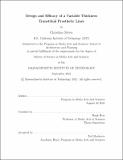Design and Efficacy of a Variable Thickness Transtibial Prosthetic Liner
Author(s)
Meyer, Christina
DownloadThesis PDF (190.7Mb)
Advisor
Herr, Hugh
Terms of use
Metadata
Show full item recordAbstract
Significant advancements in the socket design process have improved fit and comfort, however, the prosthetic liner remains a largely unaltered component with the potential to mitigate socket pain, discomfort, and irritation. During periods of prolonged knee flexion a conventional liner can cause skin irritation over the top of the patella by applying uncomfortable shear forces to the skin as well as pinching behind the knee. To mitigate these liner irritations, this thesis proposes the use of a novel, subject-specific, variable-thickness liner. To target the knee region, the liner thickness is defined as inversely proportional to the absolute value of the maximum skin strains measured during knee flexion. Areas of high strain correspond to a minimum liner thickness of 2 mm and areas of low strain correspond to a maximum liner thickness of 7mm. Static, 30 minute sit tests were done with conventional, variable and uniform thickness liners. A FLIR thermal camera captured images of the residuum without a liner before and after each test with a 10 minute rest in between tests. I hypothesize that the variable-thickness liner will improve patient comfort for the sit test compared to the uniform and conventional liners evaluated. The results of this pilot study show in the posterior knee region a 0.2% increase in temperature from the variable thickness liner and a 2.8% increase in temperature from the uniform thickness liner. In the anterior patella region there was a 5.5% decrease in temperature from the variable thickness and an average of 0% change in temperature from the uniform thickness liner. These result suggest success of the variable thickness liner at reducing skin irritation and thermal output in regions of high skin strain. A qualitative questionnaire indicated better fit of the novel variable thickness liner compared to the conventional liner. The results of this initial pilot study support the hypothesis, and provide motivation for further testing on a larger study cohort.
Date issued
2021-09Department
Program in Media Arts and Sciences (Massachusetts Institute of Technology)Publisher
Massachusetts Institute of Technology